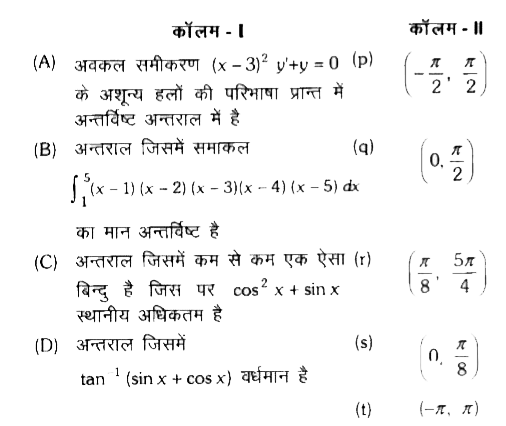माना फलन g:(−∞,∞)→(−π2,π2),g(u)=2tan−1(eu)−π2 द्वारा दिया गया है। तब g है
सम एवं (0,∞) में निरंतर वर्धमान है
विषम एवं (−∞,∞) में ह्यसमान है
विषम एवं (−∞,∞) में निरन्तर वर्धमान है
न तो सम और न ही विषम ,परन्तु (−∞,∞) में निरन्तर वर्धमान है
The correct Answer is:C
Step by step video, text & image solution for माना फलन g:(-oo,oo)to(-(pi)/(2),(pi)/(2)),g(u)=2tan^(-1)(e^(u))-(pi)/(2) द्वारा दिया गया है। तब g है by Maths experts to help you in doubts & scoring excellent marks in Class 12 exams.
Topper's Solved these Questions
- BOOK - ERRORLESS HINDICHAPTER - अवकलन तथा अवकलज के अनुप्रयोगEXERCISE - MULTIPLE CHOICE QUESTIONS (रोले की प्रमेय, लेग्रांज की मध्यमान प्रमेय )26videos
अवकलन तथा अवकलज के अनुप्रयोग
- BOOK - ERRORLESS HINDICHAPTER - अवकलन तथा अवकलज के अनुप्रयोगEXERCISE - EXERCISE534videos
अवकलन तथा अवकलज के अनुप्रयोग
- BOOK - ERRORLESS HINDICHAPTER - अवकलन तथा अवकलज के अनुप्रयोगEXERCISE - MULTIPLE CHOICE QUESTIONS (उच्चिष्ठ तथा निम्निष्ठ)122videos
अवकलन तथा अवकलज के अनुप्रयोग
- BOOK - ERRORLESS HINDICHAPTER - अवकल समीकरण EXERCISE - JEE Advanced ( Matrix Match type questions )3videos
अवकल समीकरण
- BOOK - ERRORLESS HINDICHAPTER - केन्द्रीय प्रवृत्ति के मापEXERCISE - Jee Advanced (Reasoning )2videos
केन्द्रीय प्रवृत्ति के माप
Similar Questions
मध्यमान प्रमेय f(b)−f(a)=(b−a)f'(c) यदि a=4,b=9 तथा f(x)=√x हो, तो c का मान है
03:10View Solutionयदि y=acos−1x1+acos−1x,z=acos−1x, तो dydz=
07:37View Solution4e2x+9e−2x का न्यूनतम मान है
02:04View Solution 01:37View Solution
01:37View Solutionकथन - 1 : प्रथम n सम धन पूर्णांकों का प्रसरण n2−14 है।
कथन - 2 : प्रथम n धन पूर्णाको का योगफल n(n+1)2 और प्रथम n धन पूर्णांको के वर्गों का योगफल n(n+1)(2n+1)6 है।View SolutionIf g(x)=∫0xcos4tdt , then g(x+π) equals: (1) (g(x)g(π) (2) g(x)+g(π) (3) g(x)−g(π) (4) g(x).g(π)
07:22View SolutionIf the function g:(-oo,oo)rarr(-(pi)/(2),(pi)/(2)) is given by g(u)=2tan^(-1)(e^(u))-(pi)/(2). Then g is
02:38View SolutionIf g(x)=2tan^-1(e^x)-pi/2 is Even /odd
03:25View SolutionLet the function g:(−∞,∞)→(−π/2,π/2) be given by g(u) =2tan−1(eu)−π2 Then g is
04:05View Solutionमान लीजिये फलन y:(−∞,∞)→(−π2,π2) इस प्रकार है कि g(u)=2tan−1eu−π2 , तब g है
03:45View Solutionमाना फलन g:(−∞,∞)−(−π2,π2),g(u)=2tan−1(eu)−π2 द्वारा परिभाषित, है, तब g है
03:04View SolutionLet the function g:(−∞,∞)→(−π2,π2) be given by g(u)=2tan−1(eu)−π2. Then g is :
04:38View SolutionLet g(x)=f(x)sinx,wheref(x) is a twice differentiable function on (−∞,∞) such that f'(−π)=1. The value of g''(−π) equals __________
03:06View SolutionLet g(x)=f(x)sinx,wheref(x) is a twice differentiable function on (−∞,∞) such that f(−π)=1. The value of ∣∣g′'(−π)∣∣ equals __________
04:12View SolutionLet g(x)=f(x)sinx,wheref(x) is a twice differentiable function on (−∞,∞) such that f'(−π)=1. The value of ∣∣g−π∣∣ equals __________
03:50View SolutionIf g(x)=∫0xcos4tdt , then g(x+π) equals: (1) g(x)g(π) (2) g(x)+g(π) (3) g(x)−g(π) (4) g(x).g(π)
04:04View Solution

